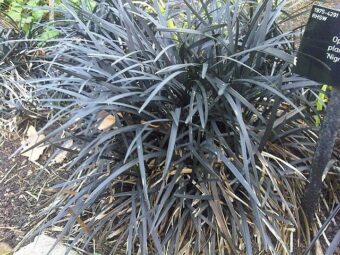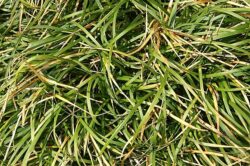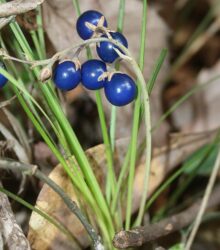In this article, we will discover how to grow the wonderful colourful plant of Ophiopogon in containers. It looks like grass but Lilyturf or Mondo grass as it is commonly called is not. It is a perennial that belongs to the Lily family and is grown for the handsome, evergreen leaves. The plants may look spidery, with its narrow arching leaves that make the plant. It spreads via underground runners that will soon fill a container and where in the future means that the plant will need to be divided.

In summer, small, white flowers appear that are followed by black berries, but they are insignificant compared to the leaves that are produced. Although green varieties exist, the black cultivars are more popular where they can be admired under shade, especially under tall trees and shrubs. The plants go well with silvery foliage plants and those that have metallic blue leaves.
GROWING OPHIOPOGON IN CONTAINERS
Firstly, choose a container that is large enough for the plant in question, 20cm or larger in diameter is ideal for this 60cm tall plant. Whatever you choose make sure it has plenty of drainage holes inside as the plant hates to have the roots in constant moisture. To the container, add a 1cm layer of gravel to help to achieve this.
On top of this, add a humus-rich, slightly acidic, multipurpose compost to which 10% by volume of sand has been added. The growing media used must be well-draining to prevent root rot. If your compost is not acidic enough when you test with a pH meter, then you can make it more acidic by adding a couple of handfuls of ericaceous compost or leaf mould to decrease the pH.
To this, dig a hole that is slightly bigger than the root ball it came in the original container. Drop the plant in so that the top of the root ball is at the same level as the top of the surface of the compost. Backfill with the growing media so that no gap remains. If any gaps remain, you can fill them with more growing media. Firm the plant in and water well.
Once established the plant will take good levels of drought, but until then water when 5cm below the top of the surface of the compost feels dry to the touch.
DO NOT OVERFERTILIZE
As the plant is vigorous, it will not need much in the way of fertilizing, I would not feed unless the plant is showing obvious signs of a nutrient deficiency. In this case, I would give a balanced liquid fertilizer such as Phostrogen to return the plant back to health.

You can place the container in full sun or partial shade, where the black leaves will darken further in this kind of light (full sun).
Eventually, after several years, the plant will need to be divided. This can be done in spring by removing the plant from the pot. You can then gently pull the plant apart ensuring one growing crown in each division to help create new plants. It does not need to be cut back as it is slow-growing and will spread over a long period of time.
PESTS AND DISEASES
This plant does not suffer from many diseases and tends to be trouble-free. The only problem is that slugs and snails may find new growth too irresistible. The best way to avoid this is to sprinkle slug pellets around the plant or by using wool deterrent matting.
VARIETIES TO GROW
The following varieties are recommended to be grown in containers:
Ophiopogon planiscapus ‘Nigrescens’ that is also sold as ‘Black Dragon’, ‘Ebony Knight’ or ‘Arabicus’ where it produces black, grass-like leaves.
Ophiopogon planiscapus is the original, evergreen plant that has green, grass-like leaves, where it will grow up to 15cm high. In summer, white flowers appear that are followed by blue berries in autumn.

‘Blackbeard’ is another black variety that is slightly taller. It produces white flowers with a splash of purple that is followed by attractive berries in autumn.
Ophiopogon japonicus is a compact form that has evergreen, grass-like green leaves. It only grows up to 10cm tall and produces pale lilac flowers in summer.
CONCLUSIONS
In this article, we have discussed how to grow Ophiopogon in containers to bring much-needed colour. They are easy to grow, not requiring much in the need or care or attention, apart from dividing once every few years.
A plant that will do well in the shade or in full sun. A plant that is worthy of praise and pride in your container garden.
If you have any questions or comments that you wish to make on growing Ophiopogon in containers, please do so in the comment box below.
Happy Ophiopogon growing.
